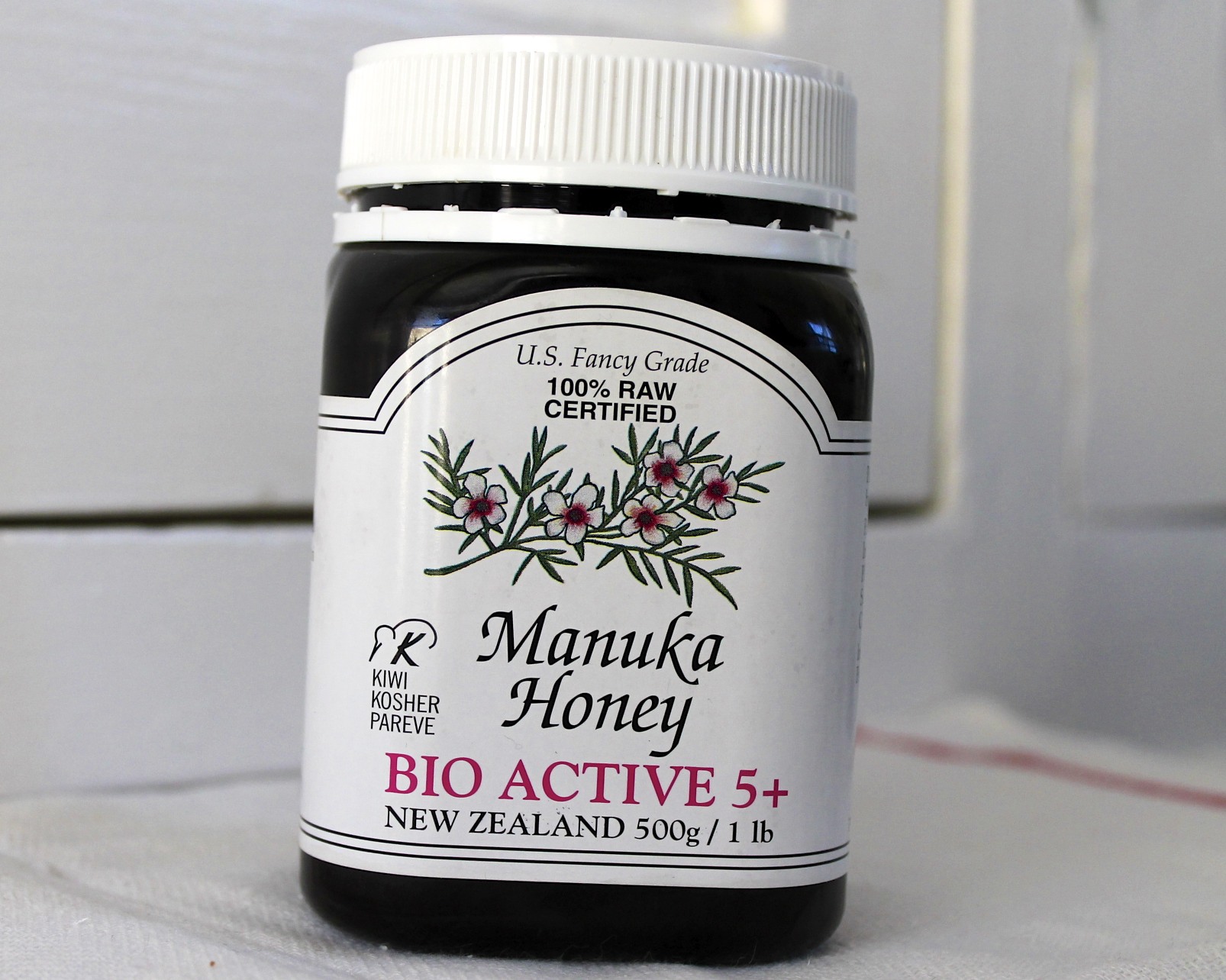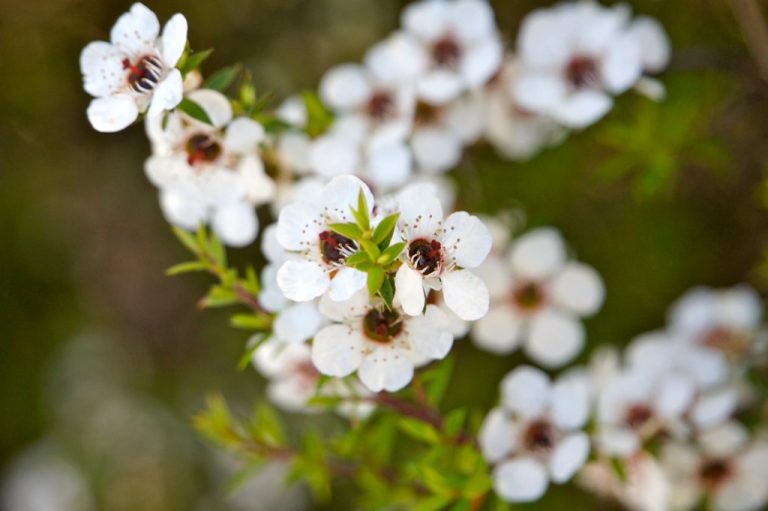The term mānuka is the Maori name for the Leptospermum shrub, a member of the Myrtacaea family which is generally referred to as a “tea tree,” not to be confused with Melaleuca, the Australian tea tree, from which tea tree oil is produced. Because of its remarkable antibacterial properties, this rare honey has piqued the attention of health-conscious aficionados.
Although mānuka can also be found in Australia, New Zealand accounts for almost all the world’s production, with exports worth 300 million NZ dollars ($204m), expected to rise to 1.2 billion NZ ($800m) by 2028.
The busy producers
Mānuka honey is generated by European honey bees (Apis mellifera), introduced to New Zealand nearly 200 years ago. The delicate mānuka flower bloom time lasts 2-6 weeks, with a peak in the middle of December (the beginning of Summer in New Zealand.)
“The plant itself is very rare. It’s difficult to harvest because the flower is only open for 12 days, and sometimes we have to use helicopters to collect this honey.” John Rawcliffe from the Mānuka Factor Honey Association told Business Insider.
Additionally, it takes bees around 22,700 separate visits to the Mānuka Flowers to collect enough nectar to produce one 17.6 oz of mānuka honey. This is due to the rarity of the bloom and the difficult-to-reach locations where mānuka shrubs naturally thrive, which makes mānuka honey a time-consuming process. One bee can only gather enough nectar to make 15 teaspoons of honey in its lifespan.
Success
You are now signed up for our newsletter
Success
Check your email to complete sign up
The colony-building insects were first brought to the Southern Hemisphere in 1839 by Mary Bumby, an English beekeeper and sister of a Methodist missionary who oversaw the growth of the entire enterprise following their arrival. On a six-month journey from England to New Zealand, she was able to maintain her two skeps [woven baskets] of honey bees alive, according to author Cliff Van Eaton, who wrote Mānuka: The Biography of an Extraordinary Honey.
“That was no mean feat, since skep beehives are much more difficult to maintain and keep alive than hives in the moveable frame equipment that we know today.”
Her apiary was set up in the low-lying areas around the mission, and along the eastern coast of the North Island, where mānuka trees were abundant. There is compelling evidence to suggest that mānuka was the source of the first honey produced in New Zealand.

Medicinal properties
While traditional Maori medicine was previously aware of its therapeutic properties,
Peter Molan, a Waikato professor, discovered mānuka honey’s exceptional antibacterial qualities in 1980 and devised the UMF (or Unique Mānuka Factor) grade. The non-peroxide activity (NPA) of the honey is determined by the UMF rating. In other words, it is the antimicrobial component of mānuka honey that distinguishes it from other types of honey.
All natural honey has long been recognized to possess antibacterial characteristics. The low pH and presence of bacteriostatic and bactericidal chemicals found in many kinds of honey are thought to be healing and curative. Honey’s “peroxide” action is attributed to the presence of hydrogen peroxide, antioxidants, lysozyme, polyphenols, phenolic acids, flavonoids, and bee peptides.
Von Eaton said, “All honey produces hydrogen peroxide when diluted. Only mānuka honey, however, also contains those extra substances that allow it to kill antibiotic-resistant bacteria commonly found in chronic wounds, bed sores and leg ulcers.”
Mānuka honey from New Zealand is currently being utilized medically because it seems to have the greatest therapeutic qualities of any honey. It has even been shown to cure MRSA Staph infections when medicines have failed.
Flowers “listen”
The mānuka blossom is delicate and sensitive to temperature, moisture, and wind. Urbanization and agriculture have pushed the formerly abundant mānuka bush into remote regions. Being away from pesticides, herbicides, and other human interaction keeps the mānuka flower, bee colonies, and mānuka honey healthy and GMO-free.
Mānuka honey is ‘monofloral,’ created from the nectar of the mānuka flower alone. Introducing colonies at the right time and place may encourage bees to harvest the mānuka flower, which is not easily controlled. Aside from pollinating the mānuka flower, bees pollinate many other flowers, resulting in ‘multi floral’ mānuka honey. This kind of honey has fewer active chemicals than monofloral mānuka and therefore does not get a UMF ranking.
According to recent research from Israel, flowers are competitive amongst each other. It is possible for them to detect the vibrations of bees’ wings and react by momentarily sweetening their nectar in order to attract pollinating insects. In order to preserve their genetic heritage, flowers have evolved the ability to filter out extraneous ‘noise,’ such as wind and other environmental factors. Mānuka blossoms, like other flowers, may be “listening” for the bees that they rely on for pollination.
Watch out for fake mānuka honey
Mānuka honey is a huge commodity in many sectors and continues to expand. This amazing honey is also utilized in cuisine, and skincare. However, fake mānuka honey has been an issue from the beginning, with extensive research and testing done on batches to ensure their validity. Some honey producers might use an MG (most genuine) or MGO rating. Honey without a UMF or MG/MGO rating is generally low-grade.
The majority of mānuka-labeled honey tested in the United Kingdom between 2011 and 2013 lacked the non-peroxide antimicrobial action of mānuka honey, according to government agency testing conducted between 2011 and 2013. In the same way, 43 out of 73 samples tested by the UMFHA in the United Kingdom, China, and Singapore in 2012–13 came back negative.
According to the results of separate UMFHA testing conducted in Hong Kong, 14 out of 56 mānuka honey samples tested were contaminated with syrup.
Labels
It may be difficult to determine whether or not you are receiving what you have paid for. Authentic mānuka honey, according to the UMF Honey Association (Unique Mānuka Factor) Honey Association, should meet all five of the following criteria:
- The UMF stamp is prominently displayed on the front label of the product.
- It is packed in jars that are identified as being from New Zealand.
- It comes from a New Zealand business that has been granted permission to use the name UMF.
- On the front label, you may find the name of the UMF licensee.
- The label has been assigned a UMF5 or above grade.
One should not let the presence of fake honey discourage you from seeking out the finest honey. Although difficult, obtaining a tasty, nutritious jar of nature’s gold nectar – pure mānuka honey – is not impossible. With the right information and perseverance, you will not have any difficulties in your search.















